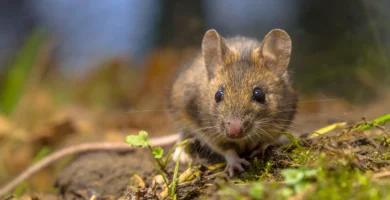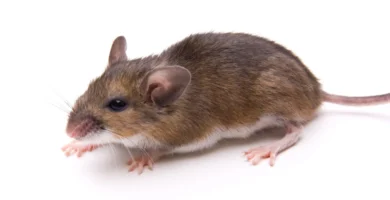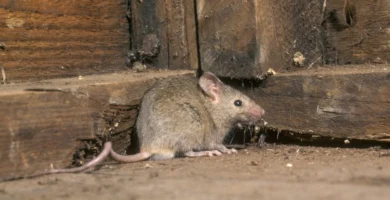
When it comes to dealing with pests, the Deer Mouse (Peromyscus maniculatus) is a significant concern for homeowners in the United States. Known for their ability to invade homes and cause various issues, effective pest control for deer mice is essential. In this article, we will explore the nature of these pests, the problems they cause, and the best methods for eliminating and preventing infestations.
Table of Contents
Understanding the Deer Mouse Problem
What are Deer Mice?
Deer mice are small rodents, typically 5 to 8 inches long, including their tail. They have large eyes, prominent ears, and a bi-colored appearance with a white underbelly and brown or grayish upper parts. These mice are named for their agility and speed, much like a deer. They are found throughout North America and are particularly common in rural and semi-rural areas.
Why Deer Mice are Considered Pests
While deer mice may seem harmless, they pose significant health risks and can cause substantial damage to property. They are notorious for carrying hantavirus, a potentially deadly disease that can be transmitted to humans through contact with rodent droppings, urine, or saliva. In addition to health risks, deer mice can chew through wires, insulation, and wood, causing structural damage to homes and creating fire hazards.
Common Habitats of Deer Mice
Deer mice prefer outdoor habitats such as forests, grasslands, and agricultural areas. However, they often seek shelter in homes, especially during colder months. They are adept at finding entry points and can squeeze through small openings, making it easy for them to invade attics, basements, and other parts of a house.
Impact of Deer Mice Infestations in Homes
Health Risks Associated with Deer Mice
One of the primary concerns with deer mice is their potential to transmit hantavirus. This virus can cause hantavirus pulmonary syndrome (HPS), a severe respiratory disease that can be fatal. Symptoms of HPS include fever, muscle aches, and shortness of breath, and it requires immediate medical attention. The presence of deer mice also increases the risk of other diseases such as leptospirosis, salmonellosis, and Lyme disease.
Structural Damage Caused by Deer Mice
Deer mice are known for their gnawing behavior. They will chew through various materials, including wood, plastic, and electrical wiring. This can lead to significant structural damage, increased fire risks due to exposed wires, and costly repairs. Additionally, their nesting habits can compromise insulation and other building materials.
Signs of a Deer Mouse Infestation
Identifying a deer mouse infestation early is crucial for effective pest control. Common signs include:
- Droppings: Small, dark pellets found in kitchens, pantries, and along walls.
- Gnaw Marks: Chewed wires, wood, and plastic.
- Nests: Made from shredded paper, fabric, and insulation, usually found in hidden areas.
- Noises: Scratching or scurrying sounds, especially at night.
- Sightings: Spotting a deer mouse inside the home, particularly during the evening.
Pest Control for Deer Mouse: Effective Methods and Strategies
How to Remove Mice from Your Home
Removing deer mice from your home requires a combination of methods to ensure complete eradication. Here are some steps to follow:
- Identify Entry Points: Inspect your home for gaps, cracks, and openings that deer mice could use to enter. Seal these entry points with steel wool, caulk, or other appropriate materials.
- Set Traps: Use snap traps, live traps, or electronic traps to catch and kill deer mice. Place them in areas where you have noticed signs of activity, such as along walls and near food sources.
- Use Bait Stations: Bait stations can help reduce the deer mouse population by delivering poison in a controlled manner. Always follow safety guidelines and keep bait stations out of reach of children and pets.
- Clean and Disinfect: Thoroughly clean areas where deer mice have been active. Use disinfectants to clean up droppings and nesting materials, and wear gloves and masks to protect yourself from potential pathogens.
Best Way to Exterminate Mice
The best way to exterminate mice is to combine multiple methods for a comprehensive approach. Here are some effective strategies:
- Integrated Pest Management (IPM): This approach combines prevention, monitoring, and control methods to manage pest populations effectively. It includes sealing entry points, using traps, and maintaining cleanliness to reduce attractants.
- Professional Pest Control Services: Hiring a professional pest control company ensures a thorough and effective extermination process. Professionals have the expertise and tools to handle infestations safely and efficiently.
- Using High-Quality Traps and Baits: Invest in high-quality traps and baits to ensure maximum effectiveness. Follow instructions carefully and place traps strategically for the best results.
Professional Pest Control for Deer Mouse
If a deer mouse infestation persists despite your efforts, it may be time to call in the professionals. Here’s what to expect from professional pest control services:
What Do Exterminators Do for Mice?
Professional exterminators follow a systematic process to eliminate deer mice from your home:
- Inspection: They conduct a thorough inspection to identify the extent of the infestation and locate entry points and nesting areas.
- Treatment Plan: Based on the inspection, they develop a customized treatment plan that includes trapping, baiting, and exclusion methods.
- Implementation: They implement the treatment plan, using high-quality traps, baits, and exclusion materials to eliminate the mice and prevent future infestations.
- Follow-Up: Exterminators often provide follow-up visits to ensure the infestation is completely eradicated and to address any remaining issues.
Choosing the Best Exterminator for Deer Mice
When selecting a professional pest control service, consider the following factors:
- Experience: Choose a company with experience in dealing with deer mice specifically.
- Reputation: Check online reviews and ask for recommendations to find a reputable service provider.
- Licensing and Certification: Ensure the company is licensed and certified to perform pest control services in your area.
- Guarantee: Look for a company that offers a satisfaction guarantee or warranty on their services.
DIY Pest Control for Deer Mouse
While professional services are often the most effective, some homeowners prefer to tackle the problem themselves. Here are some DIY methods:
Best Poison for Deer Mice
When using poison, it’s crucial to choose a product that is effective yet safe to use in a residential setting. Some popular options include:
- Anticoagulants: These poisons cause internal bleeding in mice, leading to death. They are available in various forms, including pellets and blocks.
- Bromethalin: A potent neurotoxin that kills mice quickly. It is effective but must be used with caution due to its toxicity.
Best Bait for Deer Mice
Using the right bait can significantly increase the effectiveness of traps and bait stations. Some effective baits include:
- Peanut Butter: A favorite among mice, peanut butter is sticky and difficult for them to remove without triggering the trap.
- Seeds and Nuts: Sunflower seeds, almonds, and other nuts are attractive to deer mice.
- Chocolate: Mice have a sweet tooth and are often drawn to chocolate.
Preventing Deer Mouse Infestations
Keeping Mice Out of House
Prevention is key to avoiding future infestations. Here are some tips to keep deer mice out of your home:
- Seal Entry Points: Inspect your home regularly and seal any gaps, cracks, or openings that could serve as entry points.
- Keep Food Secure: Store food in airtight containers and clean up spills and crumbs promptly.
- Maintain Cleanliness: Keep your home clean and clutter-free, especially in areas like kitchens and pantries.
- Eliminate Nesting Sites: Remove piles of debris, leaves, and firewood from around your home, as these can serve as nesting sites for deer mice.
Long-Term Prevention Strategies
For long-term prevention, consider implementing these strategies:
- Regular Inspections: Conduct regular inspections of your home and property to identify and address potential issues before they become infestations.
- Professional Monitoring: Some pest control companies offer monitoring services to keep an eye on potential pest activity and address issues proactively.
- Education: Stay informed about deer mice and other pests, and educate your family members on how to prevent infestations.
Other common species of mice in the USA
24 July, 2024

Pest Control for Field Mouse
24 July, 2024

Pest Control for White Footed Mouse
24 July, 2024

Pest Control for House Mouse
Frequently Asked Questions (FAQs) About Pest Control for Deer Mouse
Are Deer Mice Harder to Get Rid Of?
Deer mice can indeed be challenging to eliminate due to their agility, rapid reproduction, and ability to squeeze through small openings. They are nocturnal and cautious, making them difficult to trap. However, with a comprehensive pest control strategy that includes sealing entry points, using traps, and maintaining cleanliness, they can be effectively managed and eradicated.
What is the Best Poison for Deer Mice?
The most effective poisons for deer mice include anticoagulants and bromethalin. These should be used with caution to prevent accidental poisoning of non-target animals and humans. It’s essential to follow all safety guidelines and consider professional pest control services for severe infestations.
What is the Best Bait for Deer Mice?
Do Deer Mice Always Have Hantavirus?
Not all deer mice carry hantavirus, but they are known carriers, and the risk is significant enough to warrant caution. Hantavirus can cause severe respiratory illness and is transmitted through contact with mouse droppings, urine, or saliva. Precautions should always be taken when dealing with deer mice infestations.
How to Get Rid of Deer Mice?
To effectively get rid of deer mice, use a combination of traps, baits, and exclusion methods. Seal all potential entry points larger than 1/4 inch, maintain cleanliness to eliminate food sources, and consider professional pest control services for severe infestations. Regular monitoring is crucial to prevent re-infestation.
What Are the Odds of Catching Hantavirus?
How to Prevent Deer Mouse Infestations?
Preventing deer mouse infestations involves sealing entry points, maintaining cleanliness, and eliminating potential nesting sites. Regular inspections and professional monitoring can help detect early signs of infestation. Additionally, reducing outdoor clutter and storing food in rodent-proof containers can deter mice.
What Attracts Deer Mice to Homes?
Can Deer Mice Cause Allergies?
By understanding the nature of deer mice, recognizing the signs of an infestation, and implementing effective pest control methods, you can protect your home and family from these troublesome pests. Whether you choose to tackle the problem yourself or enlist the help of professionals, a comprehensive approach will ensure that your home remains deer mouse-free.
For more information on pest control for other household pests, consult reputable sources such as the Centers for Disease Control and Prevention (CDC) and local pest control professionals.
